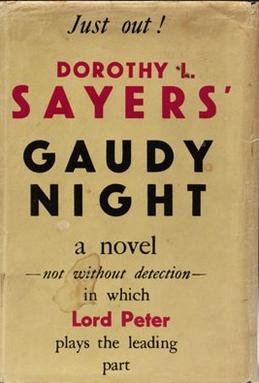
Gaudy Night (1935) is a mystery novel by Dorothy L. Sayers, the tenth featuring Lord Peter Wimsey, and the third including Harriet Vane.

Lord Peter Death Bredon Wimsey is the fictional protagonist in a series of detective novels and short stories by Dorothy L. Sayers. A dilettante who solves mysteries for his own amusement, Wimsey is an archetype for the British gentleman detective. He is often assisted by his valet and former batman, Mervyn Bunter; by his good friend and later brother-in-law, police detective Charles Parker; and, in a few books, by Harriet Vane, who becomes his wife.

Murder Must Advertise is a 1933 mystery novel by Dorothy L. Sayers, the eighth in her series featuring Lord Peter Wimsey. Most of the action of the novel takes place in an advertising agency, a setting with which Sayers was familiar as she had herself worked as an advertising copywriter until 1931.
Lindsey Davis is an English historical novelist, best known as the author of the Falco series of historical crime stories set in ancient Rome and its empire. She is a recipient of the Cartier Diamond Dagger award.
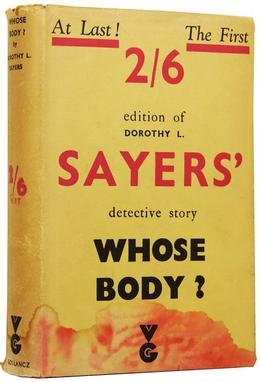
Whose Body? is a mystery novel by Dorothy L. Sayers first published in 1923 in the US by Boni & Liveright, and in the UK by T. Fisher Unwin. It was her debut novel, and the book in which she introduced the character of Lord Peter Wimsey.

Clouds of Witness is a 1926 mystery novel by Dorothy L. Sayers, the second in her series featuring Lord Peter Wimsey. In the United States the novel was first published in 1927 under the title Clouds of Witnesses.
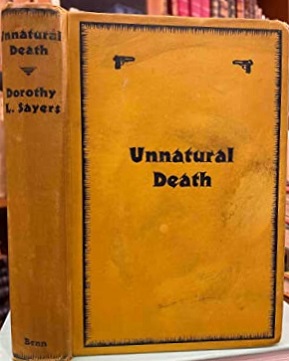
Unnatural Death is a 1927 mystery novel by Dorothy L. Sayers, her third featuring Lord Peter Wimsey. It was published under the title The Dawson Pedigree in the United States in 1928.

Strong Poison is a 1930 mystery novel by Dorothy L. Sayers, her fifth featuring Lord Peter Wimsey and the first in which Harriet Vane appears.

Have His Carcase is a 1932 locked-room mystery by Dorothy L. Sayers, her seventh novel featuring Lord Peter Wimsey and the second in which Harriet Vane appears. It is also included in the 1987 BBC TV series. The book marks a stage in the long drawn out courting of Harriet Vane by Wimsey. Though working closely with him on solving the book's mystery, she still refuses to marry him.
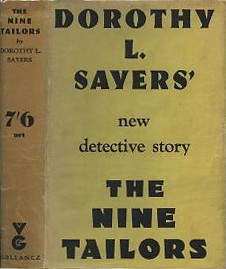
The Nine Tailors is a 1934 mystery novel by the British writer Dorothy L. Sayers, her ninth featuring Lord Peter Wimsey. The story is set in the Lincolnshire Fens, and revolves around a group of bell-ringers at the local parish church. The book has been described as Sayers' finest literary achievement, although not all critics were convinced by the mode of death, nor by the amount of technical campanology detail included.

Busman's Honeymoon is a 1937 novel by Dorothy L. Sayers, her eleventh and last featuring Lord Peter Wimsey, and her fourth and last to feature Harriet Vane.

Thrones, Dominations is a Lord Peter Wimsey–Harriet Vane murder mystery novel that Dorothy L. Sayers began writing but abandoned, and which remained at her death as fragments and notes. It was completed by Jill Paton Walsh and published in 1998. The title is a quotation from John Milton's Paradise Lost and refers to two categories of angel in the Christian angelic hierarchy.
Mervyn Bunter is a fictional character in Dorothy L. Sayers's novels and short stories. He serves as Lord Peter Wimsey's valet, and served as Wimsey's batman during the First World War. Bunter was partially based on the fictional butler Jeeves, created by P. G. Wodehouse.
In the works of Dorothy L. Sayers, the fictional title of Duke of Denver is held by Gerald Wimsey, older brother of the books' protagonist, Lord Peter Wimsey. In novels written after Sayers' death by Jill Paton Walsh, Lord Peter also eventually holds the title. Sayers and several friends constructed an elaborate backstory for the duchy.
Delano Ames was an American writer of detective stories. Ames was the author of some 20 books, many of them featuring a husband and wife detective team of amateurs named Dagobert and Jane Brown. A later series of novels involved a character named Juan Lorca, of the Spanish Civil Guard, who solved local mysteries.
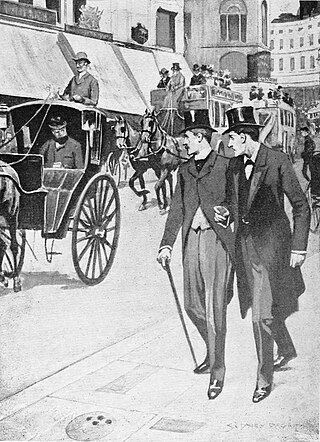
The gentleman detective, less commonly lady detective, is a type of fictional character. He has long been a staple of crime fiction, particularly in detective novels and short stories set in the United Kingdom in the Golden Age. The heroes of these adventures are typically both gentlemen by conduct and often also members of the British gentry. The literary heroes being in opposition to professional police force detectives from the working classes.

Dorothy Leigh Sayers was an English crime novelist, playwright, translator and critic.
Robert Eustace was the pen name of Eustace Robert Barton (1869–1943), an English doctor and author of mystery and crime fiction with a theme of scientific innovation. He also wrote as Eustace Robert Rawlings. Eustace often collaborated with other writers, producing a number of works with the author L. T. Meade and others. He is credited as co-author with Dorothy L. Sayers of the novel The Documents in the Case, for which he supplied the main plot idea and supporting medical and scientific details.

The Attenbury Emeralds is the third Lord Peter Wimsey-Harriet Vane detective novel written by Jill Paton Walsh. Featuring characters created by Dorothy L. Sayers, it was written with the co-operation and approval of Sayers' estate. It was published by Hodder & Stoughton in September 2010.

The Late Scholar is the fourth and final Lord Peter Wimsey-Harriet Vane detective novel written by Jill Paton Walsh. Featuring characters created by Dorothy L. Sayers, it was written with the co-operation and approval of Sayers' estate. It was published by Hodder & Stoughton on 5 December 2013 in the UK, and on 14 January 2014 in North America.









